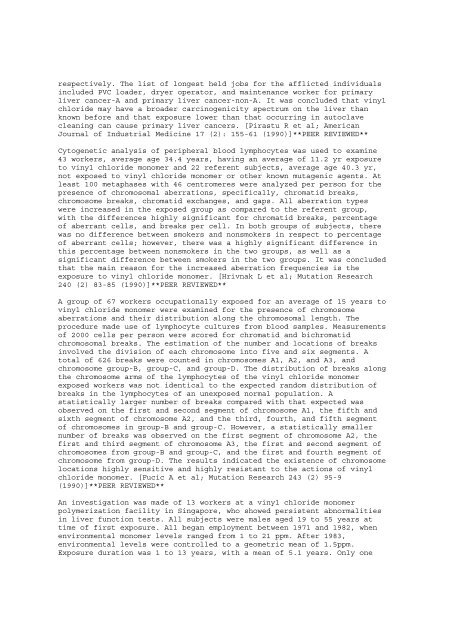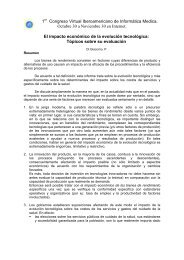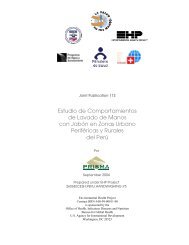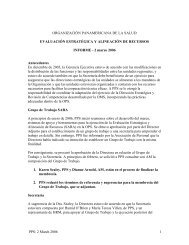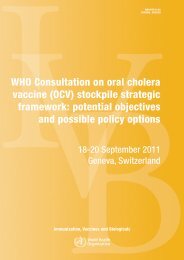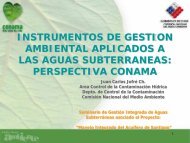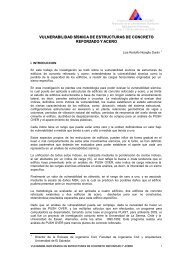a database of the National Library of M
a database of the National Library of M
a database of the National Library of M
Create successful ePaper yourself
Turn your PDF publications into a flip-book with our unique Google optimized e-Paper software.
espectively. The list <strong>of</strong> longest held jobs for <strong>the</strong> afflicted individualsincluded PVC loader, dryer operator, and maintenance worker for primaryliver cancer-A and primary liver cancer-non-A. It was concluded that vinylchloride may have a broader carcinogenicity spectrum on <strong>the</strong> liver thanknown before and that exposure lower than that occurring in autoclavecleaning can cause primary liver cancers. [Pirastu R et al; AmericanJournal <strong>of</strong> Industrial Medicine 17 (2): 155-61 (1990)]**PEER REVIEWED**Cytogenetic analysis <strong>of</strong> peripheral blood lymphocytes was used to examine43 workers, average age 34.4 years, having an average <strong>of</strong> 11.2 yr exposureto vinyl chloride monomer and 22 referent subjects, average age 40.3 yr,not exposed to vinyl chloride monomer or o<strong>the</strong>r known mutagenic agents. Atleast 100 metaphases with 46 centromeres were analyzed per person for <strong>the</strong>presence <strong>of</strong> chromosomal aberrations, specifically, chromatid breaks,chromosome breaks, chromatid exchanges, and gaps. All aberration typeswere increased in <strong>the</strong> exposed group as compared to <strong>the</strong> referent group,with <strong>the</strong> differences highly significant for chromatid breaks, percentage<strong>of</strong> aberrant cells, and breaks per cell. In both groups <strong>of</strong> subjects, <strong>the</strong>rewas no difference between smokers and nonsmokers in respect to percentage<strong>of</strong> aberrant cells; however, <strong>the</strong>re was a highly significant difference inthis percentage between nonsmokers in <strong>the</strong> two groups, as well as asignificant difference between smokers in <strong>the</strong> two groups. It was concludedthat <strong>the</strong> main reason for <strong>the</strong> increased aberration frequencies is <strong>the</strong>exposure to vinyl chloride monomer. [Hrivnak L et al; Mutation Research240 (2) 83-85 (1990)]**PEER REVIEWED**A group <strong>of</strong> 67 workers occupationally exposed for an average <strong>of</strong> 15 years tovinyl chloride monomer were examined for <strong>the</strong> presence <strong>of</strong> chromosomeaberrations and <strong>the</strong>ir distribution along <strong>the</strong> chromosomal length. Theprocedure made use <strong>of</strong> lymphocyte cultures from blood samples. Measurements<strong>of</strong> 2000 cells per person were scored for chromatid and bichromatidchromosomal breaks. The estimation <strong>of</strong> <strong>the</strong> number and locations <strong>of</strong> breaksinvolved <strong>the</strong> division <strong>of</strong> each chromosome into five and six segments. Atotal <strong>of</strong> 626 breaks were counted in chromosomes A1, A2, and A3, andchromosome group-B, group-C, and group-D. The distribution <strong>of</strong> breaks along<strong>the</strong> chromosome arms <strong>of</strong> <strong>the</strong> lymphocytes <strong>of</strong> <strong>the</strong> vinyl chloride monomerexposed workers was not identical to <strong>the</strong> expected random distribution <strong>of</strong>breaks in <strong>the</strong> lymphocytes <strong>of</strong> an unexposed normal population. Astatistically larger number <strong>of</strong> breaks compared with that expected wasobserved on <strong>the</strong> first and second segment <strong>of</strong> chromosome A1, <strong>the</strong> fifth andsixth segment <strong>of</strong> chromosome A2, and <strong>the</strong> third, fourth, and fifth segment<strong>of</strong> chromosomes in group-B and group-C. However, a statistically smallernumber <strong>of</strong> breaks was observed on <strong>the</strong> first segment <strong>of</strong> chromosome A2, <strong>the</strong>first and third segment <strong>of</strong> chromosome A3, <strong>the</strong> first and second segment <strong>of</strong>chromosomes from group-B and group-C, and <strong>the</strong> first and fourth segment <strong>of</strong>chromosome from group-D. The results indicated <strong>the</strong> existence <strong>of</strong> chromosomelocations highly sensitive and highly resistant to <strong>the</strong> actions <strong>of</strong> vinylchloride monomer. [Fucic A et al; Mutation Research 243 (2) 95-9(1990)]**PEER REVIEWED**An investigation was made <strong>of</strong> 13 workers at a vinyl chloride monomerpolymerization facility in Singapore, who showed persistent abnormalitiesin liver function tests. All subjects were males aged 19 to 55 years attime <strong>of</strong> first exposure. All began employment between 1971 and 1982, whenenvironmental monomer levels ranged from 1 to 21 ppm. After 1983,environmental levels were controlled to a geometric mean <strong>of</strong> 1.5ppm.Exposure duration was 1 to 13 years, with a mean <strong>of</strong> 5.1 years. Only one


